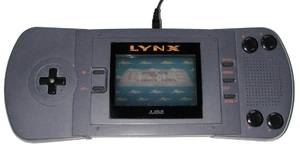|
Atari Lynx
| |
|
Manufacturer
|
|
|
Type
|
Handheld game console
|
|
Generation
|
Fourth generation
|
|
Retail availability
|
October 1989
|
|
Discontinued
|
1994
|
|
Media
|
ROM cartridges
|
|
CPU
|
MOS Technology 6502
|
The Atari Lynx is a 16-bit handheld game console that was released by Atari in September 1989. The Lynx holds the distinction of being the world's first handheld electronic game with a color LCD. The system is also notable for its forward-looking features, advanced graphics, and ambidextrous layout. As part of the fourth generation of gaming, the Lynx competed with Nintendo's Game Boy (released just a month earlier), the Sega Game Gear and NEC's TurboExpress, both released the following year.
Today, as with many older consoles, there is still a small group of devoted fans, creating and selling games for the system.
Features
The Atari Lynx has several innovative features including it being the first color handheld, with a backlit display, a switchable right-handed/left-handed (upside down) configuration, and the ability to network with up to 17 other units via its "Comlynx" system (though most games would network eight or fewer players). Comlynx was originally developed to run over infrared links (and was codenamed RedEye). This was changed to a cable-based networking system before the final release.
The Lynx was also the first gaming console with hardware support for zooming/distortion of sprites, allowing fast pseudo-3D games and a capacity for drawing filled polygons with limited CPU intervention. Blue Lightning, a game with After Burner-like graphics, was featured in TV advertising for the console.
The Atari Lynx was the first console to feature integrated math and graphics co-processors (including a Blitter unit) which aided in hardware scaling and rotation of graphical elements, over a year before the Super Nintendo, which was unable to scale sprites and confined to the limits of Mode 7.
The games were originally meant to be loaded from tape, but were later changed to load from ROM. The game data still needed to be copied from ROM to RAM before it could be used, so less memory was available and the games loaded relatively slowly.
Reception
Although it was innovative and unique for its time, gamers found the Atari Lynx to be quite large and bulky, even the 2nd version of the unit.
However, the game system was reviewed in 1990 in Dragon #155 by Hartley, Patricia, and Kirk Lesser in "The Role of Computers" column. The reviewers gave the Lynx 5 out of 5 stars, stating that it "throws the Gameboy into the prehistoric age", and praising the built-in object scaling capabilities, the multiplayer feature of the ComLynx cable, and the strong set of launch games.

